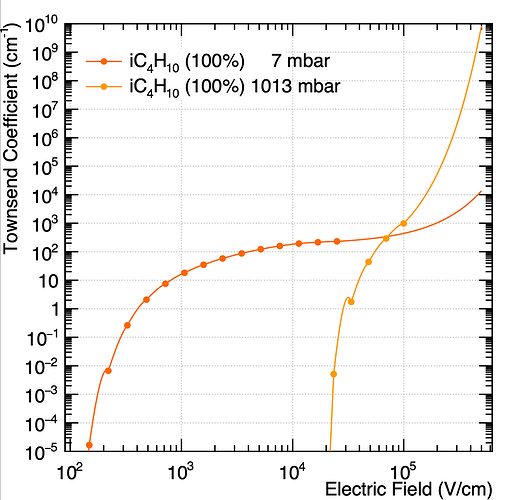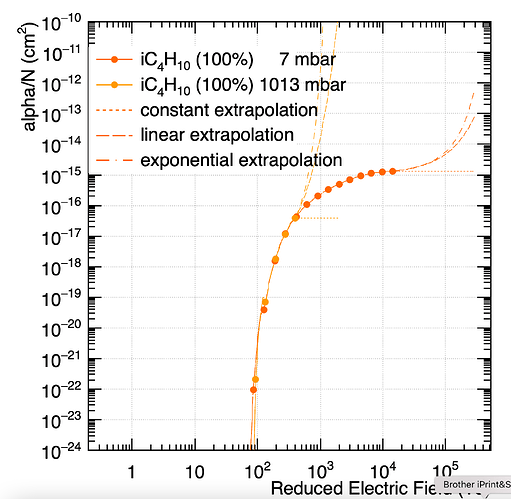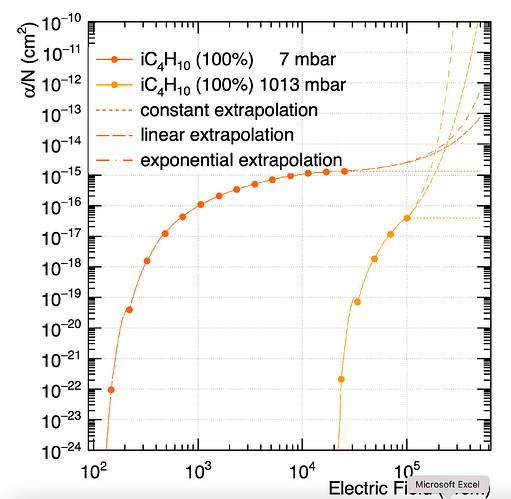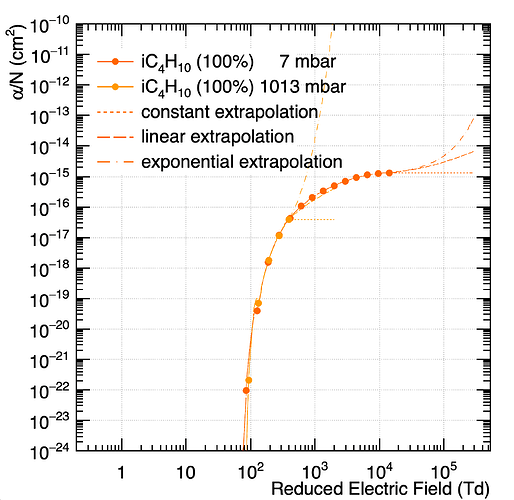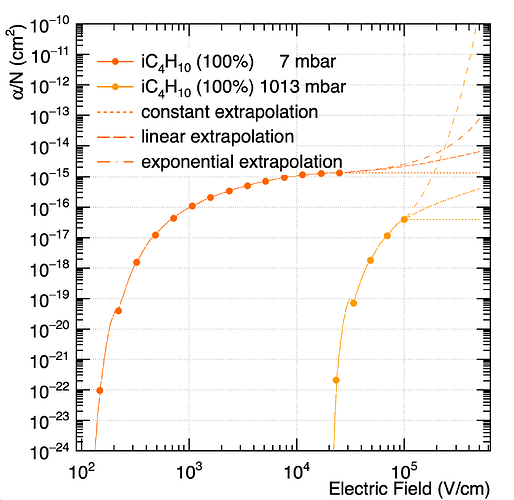Hi! I am currently working on calculating gas files with electric fields in a thin isobutane gas with thin wires at a high electric field for electron multiplication purposes. I get up to around 20-30 kV/cm, but then get an error
PROGRAM STOPPED NPONT= 8001 ITER= 379073975
I tried modifying magboltz.f to have larger arrays than 8000 and making the warning come up for larger values and recompiling Garfield (a desperate attempt at addressing this, I must admit), but the warning just comes up for whatever higher number I set. Any help in troubleshooting this would be appreciated!
The full output looks like this:
Processing 99 wires along x and y axis each.
Starting wire position -4.9
MediumMagboltz::SetComposition: iC4H10
Sorting out the gas table
Writing gas file for E = 30000 V
MediumMagboltz::GenerateGasTable: Found 15 excitations and 3 ionisations.
iC4H10 EXC. TRIPLET ELOSS= 7.2 , energy = 7.19993 eV.
iC4H10 EXC. TRIPLET ELOSS= 8.6 , energy = 8.59992 eV.
iC4H10 EXC. SINGLET F=.0013 ELOSS= 7.5 , energy = 7.49993 eV.
iC4H10 EXC. SINGLET F=.0150 ELOSS= 8.0 , energy = 7.99992 eV.
iC4H10 EXC. SINGLET F=.1140 ELOSS= 8.5 , energy = 8.49992 eV.
iC4H10 EXC. SINGLET F=.1570 ELOSS= 9.0 , energy = 8.99992 eV.
iC4H10 EXC. SINGLET F=.1710 ELOSS= 9.5 , energy = 9.49991 eV.
iC4H10 EXC. SINGLET F=.1880 ELOSS= 10.0 , energy = 9.99991 eV.
iC4H10 EXC. SINGLET F=.2050 ELOSS= 10.5 , energy = 10.4999 eV.
iC4H10 EXC. SINGLET F=.1930 ELOSS= 11.0 , energy = 10.9999 eV.
iC4H10 EXC. SINGLET F=.1620 ELOSS= 11.5 , energy = 11.4999 eV.
iC4H10 EXC. SINGLET F=.1030 ELOSS= 12.0 , energy = 11.9999 eV.
iC4H10 EXC. SINGLET F=.0670 ELOSS= 12.5 , energy = 12.4999 eV.
iC4H10 EXC. SINGLET F=.0640 ELOSS= 13.0 , energy = 12.9999 eV.
iC4H10 EXC. SINGLET F=.0280 ELOSS= 13.5 , energy = 13.4999 eV.
iC4H10 IONISATION ELOSS= 10.67 , energy = 10.6699 eV.
iC4H10 IONISATION-EXCITATION (BREAKUP) ELOSS= 17.0 , energy = 16.9998 eV.
iC4H10 IONISATION K-SHELL ELOSS= 285.0 , energy = 284.997 eV.
MediumMagboltz::GenerateGasTable: E = 30000 V/cm, B = 0 T, angle: 1.5708 rad
RM48 INITIALIZED: 54217137 0 0
PROGRAM MAGBOLTZ 2 VERSION 11.19
MONTE CARLO SOLUTION FOR MIXTURE OF 1 GASES.
------------------------------------------------------
GASES USED PERCENTAGE USED
ISO-C4H10 2014 ANISOTRPIC 100.0000
GAS TEMPERATURE = 20.0 DEGREES CENTIGRADE.
GAS PRESSURE = 5.3 TORR.
INTEGRATION FROM 0.0 TO ******** EV. IN 4000 STEPS.
PENNING EFFECTS NOT INCLUDED
ANISOTROPIC SCATTERING TYPE 2 (OKHRIMOVSKYY) USED IF AVAILABLE
SHORT DECORRELATION LENGTH = 400000 COLLISIONS.
THERMAL MOTION OF GAS INCLUDED
ELECTRIC FIELD = 30000.0000 VOLTS/CM.
MAGNETIC FIELD = 0.0000 KILOGAUSS.
ANGLE BETWEEN ELECTRIC AND MAGNETIC FIELD = 90.000 DEGREES.
CYCLOTRON FREQ. = 0.000D+00 RADIANS/PICOSECOND
INITIAL ELECTRON ENERGY =5242.880 EV.
TOTAL NUMBER OF REAL COLLISIONS = 40000000
NULL COLLISION FREQUENCY FOR EACH GAS COMPONENT IN UNITS OF (*10**12/SEC)
0.242D+00 0.000D+00 0.000D+00
0.000D+00 0.000D+00 0.000D+00
VEL POS TIME ENERGY COUNT DIFXX DIFYY DIFZZ
10854.89 0.216D+03 0.199D+08 953.7614 10 ******** ******** 0.0
10878.53 0.434D+03 0.399D+08 959.2296 20 ******** ******** 0.0
10842.45 0.649D+03 0.599D+08 948.3591 30 ******** ******** ********
10840.89 0.865D+03 0.798D+08 947.1731 40 ******** ******** ********
10832.42 0.108D+04 0.997D+08 945.6626 50 ******** ******** ********
10831.58 0.130D+04 0.120D+09 944.2754 60 ******** ******** ********
10835.47 0.151D+04 0.140D+09 945.1777 70 ******** ******** ********
10835.25 0.173D+04 0.160D+09 944.7176 80 ******** ******** ********
10838.04 0.195D+04 0.180D+09 946.1796 90 ******** ******** ********
10833.12 0.216D+04 0.199D+09 944.9686 100 ******** ******** ********
-----------------------------------------------------------------------------
-----------------------------------------------------------------------------
CALCULATED MAX. COLLISION TIME = 278.02 PICOSECONDS.
NUMBER OF NULL COLLISIONS = 8316124
NUMBER OF REAL COLLISIONS = 40000000
Z DRIFT VELOCITY = 0.1083E+05 MICRONS/NANOSECOND +- 0.11%
Y DRIFT VELOCITY = 0.0000E+00 MICRONS/NANOSECOND +- 0.00%
X DRIFT VELOCITY = 0.0000E+00 MICRONS/NANOSECOND +- 0.00%
DIFFUSION IN CM**2/SEC.
TRANSVERSE DIFFUSION = 0.7602D+07 +- 9.31%
=210.53299 EV. +- 9.308%
= 1184.717 MICRONS/CENTIMETER**0.5 +- 4.65%
LONGITUDINAL DIFFUSION = 0.2023D+09 +- 15.0%
=5601.3565 EV. +- 14.96%
= 6110.841 MICRONS/CENTIMETER**0.5 +- 7.48%
IONISATION RATE /CM.= 0.8309D+02 +/- 0.02 PERCENT.
ATTACHMENT RATE /CM.= 0.0000D+00 +/- 0.00 PERCENT.
MEAN ELECTRON ENERGY = 944.9686 EV. ERROR = +- 0.39%
SOLUTION FOR STEADY STATE TOWNSEND PARAMETERS
-------------------------------------------------
SPACE STEP BETWEEN SAMPLING PLANES = 0.15556D+03 MICRONS.
PROGRAM STOPPED NPONT= 8001 ITER= 379073975
And the relevant code is here:
const float P_mbar = 7; //7 mbar isobutane in the volume
const float P = 0.7500617 * P_mbar; //Pressure needed in in torr
const float V_wire = 650.;
const double radius = 0.003; //Wire radius
const double halflength = 5.; //Wire half-length
const double chamber_depth = 1.;
const float pitch = 0.1; //Distance between wires in cm
//const float mylar_thickness = 0.00009;
const float mylar_thickness = 0.;
const float plot_z_height = 0.6;
const float wires1_height = 0.3;
const float wires2_height = 0.9;
const float cathode_height = 0.6;
//Geometry
GeometrySimple geo;
std::vector< std::vector<SolidWire> > Wires; //Vector to list wires
Wires.resize(2); //Column 0 is for x wires, column 1 is for y wires
float start_wire_pos = -1. * halflength; //Position in cm of first wire in cm in along +/-5 cm axis
float end_wire_pos = halflength; //Same as above but last wire
int N_wires = floor((end_wire_pos - start_wire_pos)) / pitch; //Number of wires fitting into that space
MediumConductor metal;
//Iteratively calculate x and y wire plane positions and add them to vector
for(int i = 0; i <= N_wires; i++){
float wire_pos = start_wire_pos + (float)i * pitch;
if(i == 1){std::cout << " Starting wire position " << wire_pos << std::endl;}
SolidWire wire1(0., wire_pos, wires1_height, radius, halflength, 1, 0, 0);
SolidWire wire2(wire_pos, 0., wires2_height, radius, halflength, 0, 1, 0);
wire1.SetBoundaryPotential(V_wire);
wire2.SetBoundaryPotential(V_wire);
Wires[0].push_back(wire1);
Wires[1].push_back(wire2);
}
//Add wires to geometry
for(int i = 0; i < (int)Wires[0].size(); i++){
geo.AddSolid(&Wires[0][i], &metal);
geo.AddSolid(&Wires[1][i], &metal);
}
//MediumConductor mylar;
MediumMylar mylar;
//Create a solid cathode plane made of Mylar between x and y wire planes
SolidBox cathode(0., 0., cathode_height, halflength, halflength, mylar_thickness / 2.);
//Cathode is grounded
cathode.SetBoundaryPotential(0.);
geo.AddSolid(&cathode, &mylar);
//Set up gas
MediumMagboltz gas("ic4h10", 100.);
gas.SetPressure(P);
gas.SetTemperature(293.15); //Kelvin
gas.EnableThermalMotion(true);
std::vector<double> Es = {30000., 40000., 50000., 100000., 200000., 300000.};
const int ncoll = 1;
std::vector<double> bfields = {0.};
std::vector<double> angles = {1.570796};
for(int i = 0; i < (int)Es.size(); i++){
std::vector<double> efields = {Es[i]};
std::cout << "Writing gas file for E = " << Es[i] << " V" << std::endl << std::endl;
gas.SetFieldGrid(efields, bfields, angles);
gas.GenerateGasTable(ncoll);
std::string gas_fname = "Gas_Tables/isobutane_";
std::stringstream nameformat;
nameformat << Es[i];
gas_fname += nameformat.str();
nameformat.str("");
gas_fname += ".gas";
gas.WriteGasFile(gas_fname);
std::cout << std::endl << std::endl << "Written" << std::endl << std::endl << std::endl;
}
geo.SetMedium(&gas);

